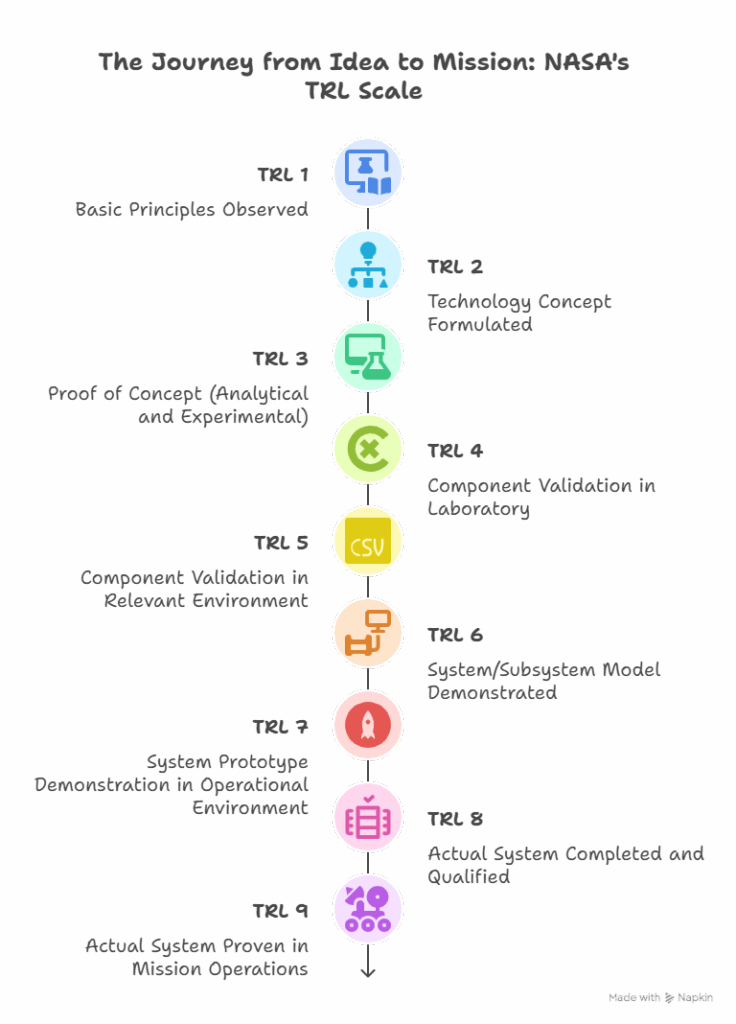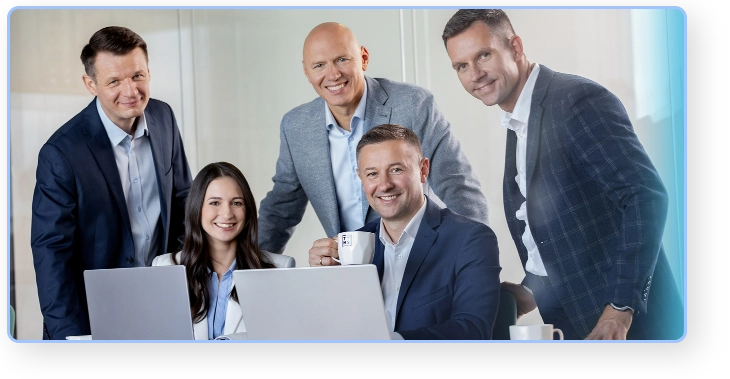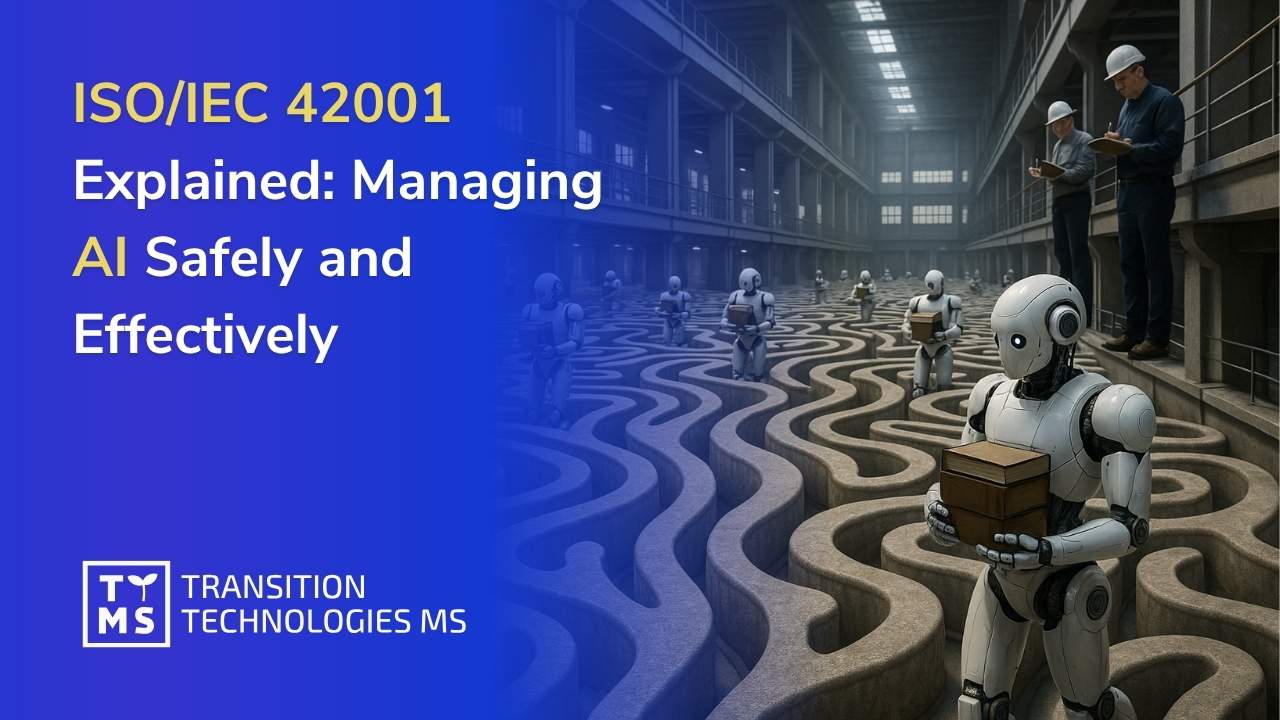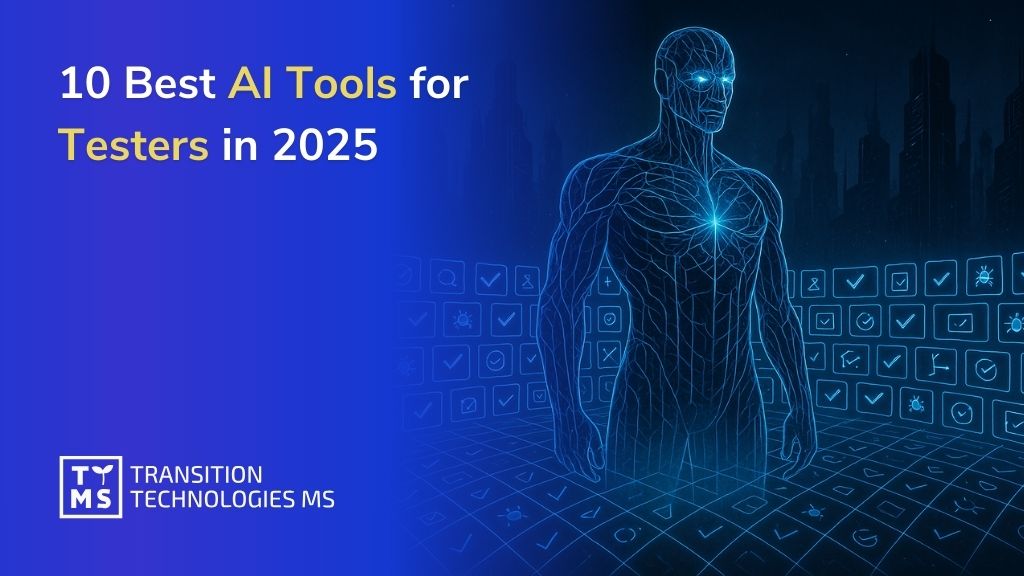Technology Readiness Levels (TRL) are a measurement scale for assessing the maturity of a technology, widely used in the space industry (and beyond) to evaluate how far a new technology has progressed towards practical use. The scale consists of nine levels, from TRL 1 at the very beginning of an idea or concept, up to TRL 9 which denotes a fully mature technology proven in real operational conditions. This framework was originally developed by NASA in the 1970s and later adopted by organizations like the U.S. Department of Defense, the European Space Agency (ESA), and the European Union to ensure consistent discussions of technology maturity across different projects. In essence, TRLs provide a common language for engineers, managers, and investors to gauge how ready a technology is for deployment.
What Are Technology Readiness Levels?
In simple terms, a technology’s TRL indicates how far along it is in development, from the earliest theoretical research to a functioning system in the field. A new concept starts at the lowest level (TRL 1) and advances through experimentation, prototyping, and testing until it reaches the highest level (TRL 9), meaning it has been proven in an actual operational environment (for space projects, this typically means a successful flight mission). Each step up the TRL ladder represents a milestone in the project’s evolution, reducing technical uncertainties and moving closer to application. Originally introduced by NASA, the TRL scale quickly became a standard in project management because it helps quantify progress and risk – a TRL 3 technology (for example) is understood to be at an early lab demonstration stage, whereas a TRL 7 or 8 technology is nearing real-world use. This common understanding is valuable for planning, funding decisions, and cross-team communication in complex aerospace projects.
The 9 Levels of the TRL Scale
According to NASA and other agencies, the TRL scale is defined as follows:
- TRL 1 – Basic Principles Observed: Scientific research is just beginning. The fundamental principles of a new concept are observed and reported, but practical applications are not yet developed. (This is essentially the stage of idea inception or basic research.)
- TRL 2 – Technology Concept Formulated: The basic idea is fleshed out into a potential application. The technology concept and possible use cases are postulated, but it remains speculative – there is no experimental proof or detailed analysis yet.
- TRL 3 – Proof of Concept (Analytical and Experimental): Active research and development begin to validate the feasibility of the concept. Analytical studies and laboratory experiments are performed to demonstrate proof-of-concept for key functions or characteristics. At this stage, a laboratory demonstration or experimental prototype of the critical components is often built to show that the idea can work in principle.
- TRL 4 – Component Validation in Laboratory: A rudimentary version of the technology (breadboard) is built and tested in a lab setting. Multiple components or subsystems are integrated to verify that they work together and meet certain performance benchmarks under controlled conditions. Success at TRL 4 means the core technical components function in a lab environment.
- TRL 5 – Component Validation in Relevant Environment: The technology (still at prototype/breadboard level) is tested in an environment that simulates real-world conditions as closely as possible. This might involve environmental chambers or field test conditions relevant to the final application (for space, think vacuum chambers, radiation, or thermal conditions similar to space). Reaching TRL 5 demonstrates the technology’s performance in a simulated operational environment, bridging the gap between pure lab tests and real conditions.
- TRL 6 – System/Subsystem Model or Prototype Demonstrated in Relevant Environment: A fully functional prototype or system model is tested in a relevant environment, meaning a high-fidelity simulation or field environment that closely matches the real operational setting. By TRL 6, the prototype has working features and performance close to the final intended system, and it has undergone rigorous testing in conditions approximating its target environment (for example, a prototype satellite instrument might be tested on a high-altitude balloon or an aircraft).
- TRL 7 – System Prototype Demonstration in Operational Environment: A near-final prototype is demonstrated in an actual operational environment. For space projects, TRL 7 often means a prototype has been test-flown in space or in a mission-like scenario. This level is a significant milestone: the system prototype operates in the real world (orbit, deep space, etc.), proving that it can perform its intended functions under actual mission conditions.
- TRL 8 – Actual System Completed and Qualified Through Testing: The final system is complete and has passed all required tests and evaluations. At TRL 8, the technology is “flight qualified,” meaning it has been verified to work in its intended operational environment through testing and demonstration. Essentially, the product is ready for deployment – all designs are frozen, and the technology meets the standards and certifications needed for use in an actual mission.
- TRL 9 – Actual System Proven in Mission Operations: The technology is fully operational and has been successfully used in a mission or operational setting. Reaching TRL 9 means the system is “flight proven” – it has performed reliably during one or more real missions, meeting all objectives in an operational environment. At this point, the technology is considered mature; it has transitioned from development into real-world service.

As the above scale shows, each TRL corresponds to a phase of development in a project’s life cycle. For example, at TRL 3 the team has demonstrated a proof-of-concept in laboratory conditions (showing that the core idea is workable). By TRL 6, there is a working prototype tested in a relevant environment that approximates the final operating conditions. And by TRL 9, the system has not only been built and tested but also successfully operated in a real mission, proving its readiness beyond any doubt. Understanding these levels helps project managers and stakeholders to gauge progress: moving from one TRL to the next typically requires overcoming specific technical hurdles and completing certain tests or demonstrations.
Risk Management and the “Valley of Death” in TRL Progression
One of the key reasons the TRL framework is so valuable is that it helps in managing technological risk. Early-stage technologies (TRL 1–3) carry high uncertainty – many concepts at this stage might fail because the basic science is unproven. However, the cost of exploration at low TRLs is relatively small (mostly analytical work and bench-top experiments). As a project advances to intermediate levels (TRL 4–6), it enters a phase of building prototypes and testing in simulated environments. Here, both the investment and the stakes increase: the project is no longer just theory, but not yet proven in real deployment. This middle stage is often where projects struggle, facing what’s colloquially known as the technological “Valley of Death.”
The “Valley of Death” refers to the critical gap between a validated prototype and a fully operational system. In terms of TRL, it is most commonly associated with the transition from about TRL 5–6 to TRL 7, when a technology must move from demonstration in a relevant environment to demonstration in a true operational environment (for space, that means actually going to space). Bridging this gap is challenging because costs rise steeply and opportunities for testing can be scarce. A NASA study noted that the expense and effort required to advance a technology increase dramatically at higher TRLs – for instance, getting from TRL 5 to TRL 6 can cost multiple times more than all the work from TRL 1 to 5 combined, and moving from TRL 6 to TRL 7 is an even bigger leap. At TRL 7, an actual system prototype must be demonstrated in the target environment, which for a space technology means a flight test or orbital deployment – an endeavor requiring significant funding, meticulous engineering, and often a willingness to accept high risk. It is during this jump (often called the “TRL 6–7 transition”) that many projects falter, either due to technical issues, budget constraints, or the difficulty of securing a flight opportunity. This is the notorious “Death Valley” of tech innovation, where promising prototypes may languish without ever reaching a mission.
Effectively managing risk through this TRL valley involves careful planning and incremental testing, as well as often seeking partnerships or funding programs specifically aimed at technology demonstration. Agencies like NASA and ESA have programs to support technologies through this phase, precisely because it’s so pivotal. A successful strategy is to use iterative prototyping and demonstration projects (for example, testing on suborbital rockets, balloon flights, or the International Space Station for space tech) to gather data and build confidence gradually before committing to a full mission. Additionally, understanding where a project sits on the TRL scale allows decision-makers to tailor their expectations and risk management approach: low-TRL projects need research-oriented management and tolerance for failure, whereas high-TRL projects (closer to deployment) demand rigorous validation, quality assurance, and reliability testing to ensure mission success.
TTMS – Supporting Projects at All TRL Stages
Transition Technologies Managed Services (TTMS) is a technology partner that recognizes the importance of the TRL framework in guiding project development, especially in high-stakes sectors like space and defense. As a provider of services for the space industry, TTMS emphasizes that it can support projects at every TRL level – from early R&D and prototyping all the way to full implementation and operational deployment. In fact, TTMS notes that it offers expertise across all technology domains and “on all technology readiness levels” for space missions. This means that whether a project is just a concept on the drawing board (TRL 1–2), in the proof-of-concept or prototyping phase (TRL 3–6), or nearly ready for launch and deployment (TRL 7–9), TTMS can provide relevant support and services.
Practically, TTMS’s involvement can take many forms depending on the TRL stage. For example, in the low-TRL phases (idea, concept, and proof-of-concept), TTMS can contribute research expertise, feasibility studies, or help prepare a proof of concept through its consultants’ technical advice. This might involve software simulations, algorithm development, or lab prototyping to validate basic principles. As the project moves into mid-TRL development (building full prototypes and testing), TTMS is prepared to support the development effort by providing complete software solutions or dedicated components and engineers, ensuring that the prototype meets its requirements and can be tested in relevant conditions. For projects approaching deployment (high TRLs), TTMS can assist with final system integration, verification and validation (IV&V), and even product assurance and quality assurance processes to make sure the technology is mission-ready. Notably, TTMS has experience in space-sector Product Assurance (PA) and Quality Assurance (QA) and can cover those needs for space missions at all TRL stages – helping increase the mission’s success rate by ensuring reliability and safety standards are met.

By being able to engage at any TRL, TTMS helps organizations navigate the challenges unique to each stage. For instance, bridging the TRL 6–7 gap (“Valley of Death”) often requires not just funding but also the right technical guidance and project management expertise. TTMS’s broad experience allows it to assist teams in planning that critical jump – from preparing a robust demonstration plan to implementing risk mitigation strategies and even contributing specialized personnel for testing campaigns. In other words, TTMS offers end-to-end support: from innovative R&D (where flexibility and creativity are key) to later-stage deployment and maintenance (where process discipline and assurance dominate). This versatility is a strong asset for any space project consortium that must traverse the entire TRL spectrum to deliver a successful mission.
Conclusion
The Technology Readiness Level scale provides a clear roadmap of technological maturity, which is invaluable in the space industry for aligning expectations, managing risks, and making investment decisions. By breaking development into TRL stages, teams can celebrate progress in tangible steps – from the spark of a new idea (TRL 1) to a fully operational capability (TRL 9) – and stakeholders can communicate about the project’s status with a common understanding of what remains to be done. Importantly, recognizing the significance of each TRL also highlights why certain transitions (like moving from a tested prototype to a flight-ready system) are so challenging and crucial. This educational insight into TRLs underpins better project planning and risk management, helping to avoid pitfalls in the notorious “Valley of Death” and beyond.
For companies like TTMS that work with space-sector clients, TRLs are not just abstract labels – they guide how to tailor support and services to the project’s needs. By supporting projects across all TRL levels, TTMS demonstrates a comprehensive capability: whether it’s nurturing a concept in the lab or fine-tuning a system for launch, the goal is to help innovative technologies make it through every phase of development and ultimately achieve mission success. In summary, understanding and utilizing Technology Readiness Levels is key to driving space projects forward, and having the right partners in place at each level can make the difference in turning a promising technology into an operational reality.
FAQ
Who developed the Technology Readiness Level (TRL) scale?
The Technology Readiness Level scale was initially developed by NASA in the 1970s as a structured way to evaluate and communicate the maturity of emerging technologies. It has since been adopted globally by various organizations, including the European Space Agency (ESA), the U.S. Department of Defense, and the European Union. Its widespread use comes from its effectiveness in providing a clear, universal framework for technology assessment, helping stakeholders understand exactly how advanced a particular technology is, managing associated risks, making informed investment decisions, and facilitating clear communication between technical teams, managers, and investors across multiple industries.
Why is TRL important for space projects?
In space and defense projects, technological reliability and performance are critically important due to high stakes, substantial investments, and severe consequences in case of failures. The TRL scale helps project teams systematically address and mitigate risks at each development phase. By clearly defining stages from basic theoretical concepts (TRL 1) to fully operational, mission-proven systems (TRL 9), the scale ensures that technologies are rigorously tested and validated before deployment, thus significantly reducing uncertainties and risks inherent in these high-stakes sectors.
What does the transition from TRL 6 to TRL 7 involve?
The transition between TRL 6 (prototype tested in simulated operational conditions) and TRL 7 (demonstration of the prototype in actual operational conditions) is notoriously challenging and referred to as the “Valley of Death.” At this critical juncture, projects often face exponentially increasing costs, heightened complexity, and limited opportunities for real-world testing. Many technologies fail to make this leap due to inadequate funding, unforeseen technical challenges, or the inability to secure partnerships or test environments required for demonstration. Successfully bridging this gap requires meticulous risk management, substantial financial investment, strategic partnerships, and careful planning.
How can companies overcome the “Valley of Death”?
Organizations can overcome the “Valley of Death” by adopting a strategic and proactive approach. Key practices include securing dedicated funding specifically for advanced prototype demonstrations, establishing partnerships with governmental agencies (like NASA or ESA), academic institutions, or industry collaborators that offer testing platforms and expertise, and performing incremental and iterative testing to gradually reduce uncertainties. Robust project management, meticulous planning, and proactive risk mitigation strategies are also essential in navigating this challenging stage of technology maturation successfully.
In what ways does TTMS support space projects across different TRL stages?
TTMS provides comprehensive support tailored to each TRL stage, covering the entire technology lifecycle. During early phases (TRL 1-3), TTMS assists with foundational research, feasibility studies, and early prototyping through consulting, algorithm development, and software simulations. As technologies mature into intermediate stages (TRL 4-6), TTMS offers technical support through advanced prototype development, rigorous testing, and validation in relevant environments. Finally, for advanced stages (TRL 7-9), TTMS delivers specialized expertise in system integration, thorough verification and validation processes, product assurance (PA), and quality assurance (QA). By providing expertise tailored specifically to the requirements at each TRL, TTMS ensures a smoother progression through critical development phases, enhancing the likelihood of achieving successful operational deployment.






